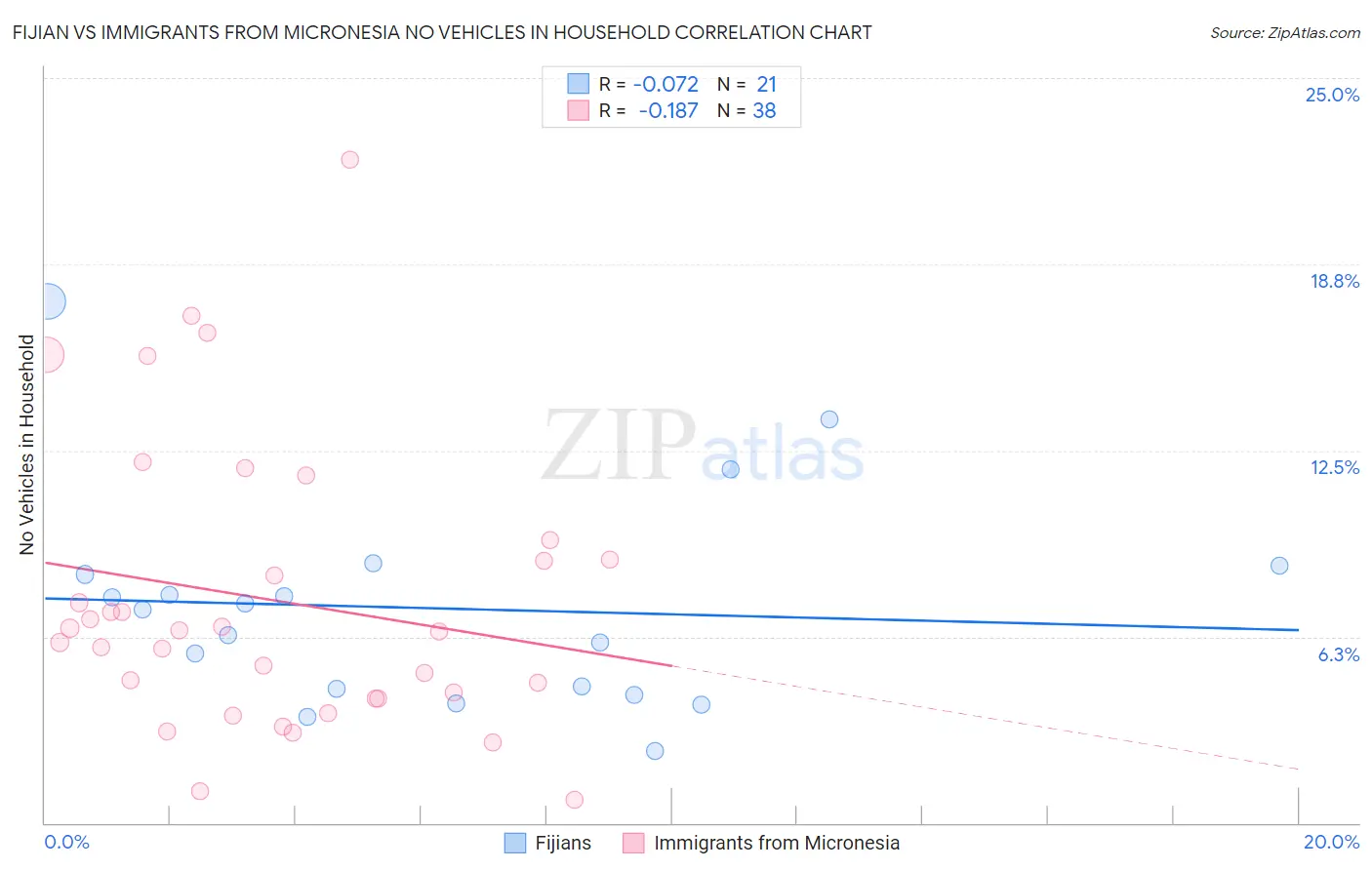Fijian vs Immigrants from Micronesia No Vehicles in Household
COMPARE
Fijian
Immigrants from Micronesia
No Vehicles in Household
No Vehicles in Household Comparison
Fijians
Immigrants from Micronesia
9.5%
NO VEHICLES IN HOUSEHOLD
92.7/ 100
METRIC RATING
119th/ 347
METRIC RANK
10.1%
NO VEHICLES IN HOUSEHOLD
70.9/ 100
METRIC RATING
156th/ 347
METRIC RANK
Fijian vs Immigrants from Micronesia No Vehicles in Household Correlation Chart
The statistical analysis conducted on geographies consisting of 55,930,698 people shows a slight negative correlation between the proportion of Fijians and percentage of households with no vehicle available in the United States with a correlation coefficient (R) of -0.072 and weighted average of 9.5%. Similarly, the statistical analysis conducted on geographies consisting of 61,571,663 people shows a poor negative correlation between the proportion of Immigrants from Micronesia and percentage of households with no vehicle available in the United States with a correlation coefficient (R) of -0.187 and weighted average of 10.1%, a difference of 6.1%.

No Vehicles in Household Correlation Summary
| Measurement | Fijian | Immigrants from Micronesia |
| Minimum | 2.4% | 0.77% |
| Maximum | 17.5% | 22.3% |
| Range | 15.1% | 21.5% |
| Mean | 7.2% | 7.5% |
| Median | 7.2% | 6.4% |
| Interquartile 25% (IQ1) | 4.4% | 4.2% |
| Interquartile 75% (IQ3) | 8.5% | 8.8% |
| Interquartile Range (IQR) | 4.1% | 4.7% |
| Standard Deviation (Sample) | 3.6% | 4.8% |
| Standard Deviation (Population) | 3.5% | 4.7% |
Similar Demographics by No Vehicles in Household
Demographics Similar to Fijians by No Vehicles in Household
In terms of no vehicles in household, the demographic groups most similar to Fijians are Immigrants from Thailand (9.5%, a difference of 0.060%), Greek (9.5%, a difference of 0.11%), Puget Sound Salish (9.5%, a difference of 0.16%), Costa Rican (9.5%, a difference of 0.21%), and Chippewa (9.4%, a difference of 0.66%).
| Demographics | Rating | Rank | No Vehicles in Household |
| Armenians | 95.0 /100 | #112 | Exceptional 9.4% |
| Immigrants | Netherlands | 94.8 /100 | #113 | Exceptional 9.4% |
| Serbians | 94.3 /100 | #114 | Exceptional 9.4% |
| Navajo | 94.2 /100 | #115 | Exceptional 9.4% |
| Japanese | 94.1 /100 | #116 | Exceptional 9.4% |
| Chippewa | 93.8 /100 | #117 | Exceptional 9.4% |
| Greeks | 92.9 /100 | #118 | Exceptional 9.5% |
| Fijians | 92.7 /100 | #119 | Exceptional 9.5% |
| Immigrants | Thailand | 92.6 /100 | #120 | Exceptional 9.5% |
| Puget Sound Salish | 92.4 /100 | #121 | Exceptional 9.5% |
| Costa Ricans | 92.3 /100 | #122 | Exceptional 9.5% |
| Blackfeet | 91.4 /100 | #123 | Exceptional 9.6% |
| Immigrants | Korea | 90.9 /100 | #124 | Exceptional 9.6% |
| Immigrants | Cameroon | 90.6 /100 | #125 | Exceptional 9.6% |
| Icelanders | 90.2 /100 | #126 | Exceptional 9.6% |
Demographics Similar to Immigrants from Micronesia by No Vehicles in Household
In terms of no vehicles in household, the demographic groups most similar to Immigrants from Micronesia are Australian (10.1%, a difference of 0.050%), Spanish American Indian (10.1%, a difference of 0.11%), Salvadoran (10.1%, a difference of 0.25%), Immigrants from Indonesia (10.1%, a difference of 0.26%), and Sioux (10.1%, a difference of 0.27%).
| Demographics | Rating | Rank | No Vehicles in Household |
| Immigrants | Uganda | 76.1 /100 | #149 | Good 10.0% |
| Colombians | 73.9 /100 | #150 | Good 10.0% |
| Immigrants | Eastern Africa | 73.8 /100 | #151 | Good 10.0% |
| Immigrants | Congo | 73.0 /100 | #152 | Good 10.1% |
| Tlingit-Haida | 72.5 /100 | #153 | Good 10.1% |
| Sioux | 72.4 /100 | #154 | Good 10.1% |
| Salvadorans | 72.4 /100 | #155 | Good 10.1% |
| Immigrants | Micronesia | 70.9 /100 | #156 | Good 10.1% |
| Australians | 70.6 /100 | #157 | Good 10.1% |
| Spanish American Indians | 70.2 /100 | #158 | Good 10.1% |
| Immigrants | Indonesia | 69.3 /100 | #159 | Good 10.1% |
| Immigrants | Middle Africa | 65.7 /100 | #160 | Good 10.2% |
| New Zealanders | 65.1 /100 | #161 | Good 10.2% |
| Immigrants | Austria | 64.4 /100 | #162 | Good 10.2% |
| Immigrants | Cambodia | 63.7 /100 | #163 | Good 10.2% |